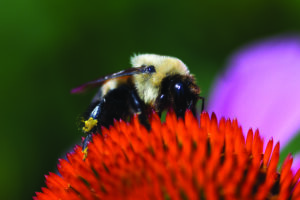
Bees not only use nectar to make honey. They collect pollen for their babies and in so doing, spread it from flower to flower. (Photo courtesy Michele Walfred)
Many of us consider insects as something to be feared, an annoyance to be swatted or a germ-carrier to be stomped on. Maybe it’s time to reconsider.
Many children are afraid of bees, most of which can’t or won’t sting unless threatened.
I have a healthy respect for the European hornet, especially the individual giant wasp that I tried to flush away with a garden hose. It followed the stream of water, then the hose, to my hand and stung me, bad. I deserved it. Now I leave them alone!
I have a friend so afraid of spiders that she nearly jumped out of a moving car when she saw a tiny creature on the dashboard. As for me, maybe I wouldn’t mind if mosquitoes, ticks and bedbugs were eradicated altogether. Spiders, flies and roaches can live — but not in my house.
Insects do serve a purpose, playing a role in pollination, nutrient cycling (decomposition), medical research, water quality, biocontrol, even “cultural services” such as artistic inspiration, spiritual significance or opportunities for recreational activities such as photography. Adding all these together, insects provide ecosystem services valued at an estimated $70 billion annually.
But insects, at least some of them, are in trouble, not just the species that are becoming extinct, but populations that are on the decline.
We all know about the monarch butterfly, whose eastern migratory population declined nearly 80 percent from 1996 to 2015. A U.S. Fish and Wildlife Service report concluded that the likelihood of near-extinction for this monarch population by 2080 is about 50 to 70 percent. Their larvae eat only milkweed, which is also disappearing, and adult monarchs need abundant nectar from flowers to build up fat reserves for their long migration.
Are you old enough to remember evenings spent capturing fireflies in a Mason jar with holes poked in the lid? We always released them before bedtime. How many of these lightning bugs have you seen lately?
Earth’s insect population is currently declining at a rate of 1 to 2% per year. That doesn’t sound alarming, but it could add up to as much as 10% in just five years — so bad that some call it an “insect apocalypse,” or “insect decline in abundance” or “insect biodiversity crisis.” Some go so far as to warn that “insects could vanish within a century” causing a “catastrophic collapse of nature’s ecosystems.” That would mean no pollinators to ensure fruit and vegetable crops; no decomposers to recycle dead plants and animals; no honey, silk, or wax, no food for birds, reptiles and mammals, including humans in many countries who eat insects themselves.
There are some who dispute these “doomsday claims.” Their own studies had different results than the 2017 German study that showed the total mass of local flying insects had fallen by 80 percent in three decades. Still, one cannot deny that an increasing human population and spreading development continues to put pressure on nature.
What is needed is a change in perception and personal opinions. Learn to love and help these amazingly diverse creatures.
People who live in urban areas may have little interaction with insects except when they invade personal space. Have you ever watched a colony of ants on the move? Or a bee move from flower to flower to flower, so matter how small? Ever had a dragonfly land on your hand while in a swimming pool? Ever watch a spider make a web across the opening at your back door, rebuilding it every night if it gets destroyed?
Garden club members may hate all insects in all life stages because they eat holes in leaves of their plants.
Those holes have kept me from entering specimens in flower shows, but I figure the bugs have to eat, too. I don’t spray unless they threaten to kill the plant.
Invasive pests from foreign lands, however, have no business being here in the first place. Japanese beetles are an example.
The spotted lanternfly, a planthopper indigenous to parts of China and Vietnam, is wreaking havoc as it spreads across our nation, state by state, including Maryland and Delaware. Crape myrtle bark scale was introduced from Asia in 2004 and is here now. These we can do without.
If you want to help out the rest of the insect world, what can you do? Dr. Akito Kawahara, associate professor and curator of the Florida Museum of Natural History has three suggestions.
First, if you own a yard, or even just a deck or balcony, plant native species that are already adapted to local conditions. Let nature survive. Native plants require less maintenance, less watering.
Second, spread the word. Talk to your neighbors and share information on social media. It’s important to we provide a corridor strip of natural habitat connecting populations of wildlife, for insects as well as animals.
Third, Kawahara urges us to pledge to protect insects. Learn more online at bit.ly/insecteffect.
My suggestion, if you have enough space, is to plant an oak tree. An oak tree supports more moths and butterflies than any other native tree species —524 insect species in all. Plus, its acorns are relished by as many as 100 animal species.




